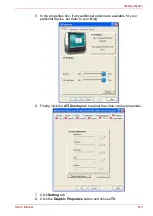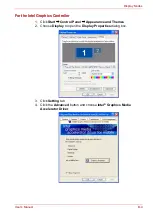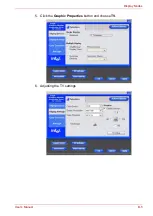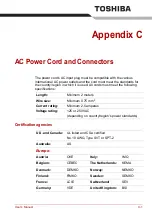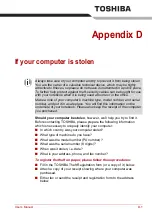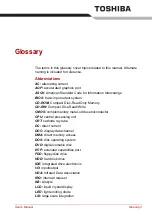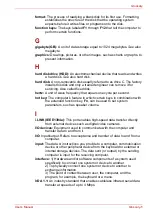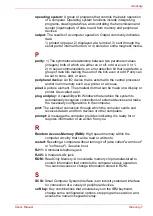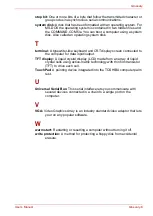
User’s Manual
Glossary-7
Glossary
operating system:
A group of programs that controls the basic operation
of a computer. Operating system functions include interpreting
programs, creating data files, and controlling the transmission and
receipt (input/output) of data to and from memory and peripheral
devices.
output:
The results of a computer operation. Output commonly indicates
data.
1) printed on paper, 2) displayed at a terminal, 3) sent through the
serial port of internal modem, or 4) stored on some magnetic media.
P
parity:
1) The symmetrical relationship between two parameter values
(integers) both of which are either on or off; odd or even; 0 or 1.
2) In serial communications, an error detection bit that is added to a
group of data bits making the sum of the bits even or odd. Parity can
be set to none, odd, or even.
peripheral device:
An I/O device that is external to the central processor
and/or main memory such as a printer or a mouse.
pixel:
A picture element. The smallest dot that can be made on a display or
printer. Also called a pel.
plug and play:
A capability with Windows that enables the system to
automatically recognize connections of external devices and make
the necessary configurations in the computer.
port:
The electrical connection through which the computer sends and
receives data to and from devices or other computers.
prompt:
A message the computer provides indicating it is ready for or
requires information or an action from you.
R
Random Access Memory (RAM):
High speed memory within the
computer circuitry that can be read or written to.
restart:
Resetting a computer without turning it off (also called "warm boot"
or "soft reset").
See also
boot.
RJ11:
A modular telephone jack.
RJ45:
A modular LAN jack.
ROM:
Read Only Memory: A nonvolatile memory chip manufactured to
contain information that controls the computer’s basic operation.
You cannot access or change information stored in ROM.
S
SCSI:
Small Computer System Interface is an industry standard interface
for connection of a variety of peripheral devices.
soft key:
Key combinations that emulate keys on the IBM keyboard,
change some configuration options, stop program execution, and
access the numeric keypad overlay.


